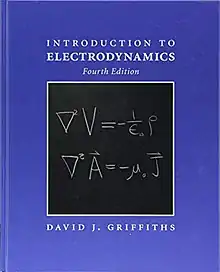Introduction to Electrodynamics
Introduction to Electrodynamics is a textbook by the physicist David J. Griffiths. Generally regarded as a standard undergraduate text on the subject,[1] it began as lecture notes that have been perfected over time.[2] Its most recent edition, the fourth, was published in 2013 by Pearson and in 2017 by Cambridge University Press. This book uses SI units (the mks convention) exclusively. A table for converting between SI and Gaussian units is given in Appendix C.[3]
 | |
| Author | David Jeffrey Griffiths |
|---|---|
| Illustrator | Derek Bacchus |
| Country | United States |
| Language | English |
| Subject | Electromagnetism |
| Genre | Non-fiction |
| Publisher | Pearson Cambridge University Press |
Publication date | 1981, 1989, 1999, 2013, 2017 |
| Pages | 599 |
| ISBN | 978-1108420419 |
Griffiths said he was able to reduce the price of his textbook on quantum mechanics simply by changing the publisher, from Pearson to Cambridge University Press.[2] He has done the same with this one. (See the ISBN in the box to the right.)
Contents
The front cover has a picture of the handwritten Poisson's equations for electricity and magnetism on a chalkboard. The first inner cover contains vector identities, vector derivatives in Cartesian, spherical, and cylindrical coordinates, and the fundamental theorems of vector calculus. The second inner cover contains the basic equations of electrodynamics, the accepted values of some fundamental constants, and the transformation equations for spherical and cylindrical coordinates.[3]
Table of Contents (4th edition)
- Preface
- Advertisement
- Chapter 1: Vector Analysis
- Chapter 2: Electrostatics
- Chapter 3: Potentials
- Chapter 4: Electric Fields in Matter
- Chapter 5: Magnetostatics
- Chapter 6: Magnetic Fields in Matter
- Chapter 7: Electrodynamics
- Chapter 8: Conservation Laws
- Chapter 9: Electromagnetic Waves
- Chapter 10: Potentials and Fields
- Chapter 11: Radiation
- Chapter 12: Electrodynamics and Relativity
- Appendix A: Vector Calculus in Curvilinear Coordinates
- Appendix B: The Helmholtz Theorem
- Appendix C: Units
- Index
Reception
Paul D. Scholten, a professor at Miami University (Ohio), opined that the first edition of this book offers a streamlined, though not always in-depth, coverage of the fundamental physics of electrodynamics. Special topics such as superconductivity or plasma physics are not mentioned. Breaking with tradition, Griffiths did not give solutions to all the odd-numbered questions in the book. Another unique feature of the first edition is the informal, even emotional, tone. The author sometimes referred to the reader directly. Physics received the primary focus. Equations are derived and explained, and common misconceptions are addressed.[4]
According to Robert W. Scharstein from the Department of Electrical Engineering at the University of Alabama, the mathematics used in the third edition is just enough to convey the subject and the problems are valuable teaching tools that do not involve the "plug and chug disease." Although students of electrical engineering are not expected to encounter complicated boundary-value problems in their career, this book is useful to them as well, because of its emphasis on conceptual rather than mathematical issues. He argued that with this book, it is possible to skip the more mathematically involved sections to the more conceptually interesting topics, such as antennas. Moreover, the tone is clear and entertaining. Using this book "rejuvenated" his enthusiasm for teaching the subject.[5]

Colin Inglefield, an associate professor of physics at Weber State University (Utah), commented that the third edition is notable for its informal and conversational style that may appeal to a large class of students. The ordering of its chapters and its contents are fairly standard and are similar to texts at the same level. The first chapter offers a valuable review of vector calculus, which is essential for understanding this subject. While most other authors, including those aimed at a more advanced audience, denote the distance from the source point to the field point by , Griffiths uses a script (see figure).[note 1] Unlike some comparable books, the level of mathematical sophistication is not particularly high. For example, Green's functions are not anywhere mentioned. Instead, physical intuition and conceptual understanding are emphasized. In fact, care is taken to address common misconceptions and pitfalls. It contains no computer exercises. Nevertheless, it is perfectly adequate for undergraduate instruction in physics. As of June 2005, Inglefield has taught three semesters using this book.[6]
Physicists Yoni Kahn of Princeton University and Adam Anderson of the Fermi National Accelerator Laboratory indicated that Griffiths' Electrodynamics offers a dependable treatment of all materials in the electromagnetism section of the Physics Graduate Record Examinations (Physics GRE) except circuit analysis.[7]
Editions
- Griffiths, David J. (1981). Introduction to electrodynamics (1st ed.). Prentice Hall. ISBN 0-13-481374-X. OCLC 6092643.
- Griffiths, David J. (1989). Introduction to electrodynamics (2nd ed.). Prentice Hall. ISBN 0-13-481367-7. OCLC 18988461.
- Griffiths, David J. (1999). Introduction to electrodynamics (3rd ed.). Prentice Hall. ISBN 0-13-805326-X. OCLC 40251748.
- Griffiths, David J. (2013). Introduction to electrodynamics (4th ed.). Pearson Education. ISBN 978-0-321-85656-2. OCLC 794711764.
- Griffiths, David J. (2017). Introduction to Electrodynamics (4th ed.). Cambridge University Press. doi:10.1017/9781108333511. ISBN 978-1-108-42041-9.
See also
- Introduction to Quantum Mechanics by the same author
- Classical Electrodynamics by John David Jackson, a commonly used graduate-level textbook.
- List of textbooks in electromagnetism
- List of textbooks on classical and quantum mechanics
- List of textbooks in thermodynamics and statistical mechanics
- List of books on general relativity
Notes
- Griffiths' Reed College faculty website contains a special script for creating in LaTeX.
References
- "Notes from the Outside Special: Meet David J. Griffiths" (PDF). The Dilated Times: The newsletter of the Drew University Society of Physics Students. Vol. 13, no. 2. Spring 2003. pp. 4–5. Archived from the original (PDF) on 2016-04-22. Retrieved 2018-08-19.
- Greg Bernhardt. Interview with a Physicist: David J. Griffiths. Physics Forum Insights. September 17, 2016.
- Griffiths, David J. (2013). Introduction to Electrodynamics (4th ed.). United States of America: Pearson. ISBN 978-0-321-85656-2.
- Scholten, Paul D. (January–February 1982). "Introduction to Electrodynamics by David J. Griffiths". American Scientist. 50 (1): 79. JSTOR 27851263.
- Scharstein, Robeit W. (February 2001). "Introduction to electrodynamics, 3rd edition (Book Review)". IEEE Antennas and Propagation Magazine. 43 (1): 102. Bibcode:2001IAPM...43..102G. doi:10.1109/MAP.2001.920021. S2CID 45624248.
- Inglefield, Colin (June 2005). "Introduction to Electrodynamics". American Journal of Physics. American Association of Physics Teachers. 73 (6): 574. Bibcode:2005AmJPh..73..574G. doi:10.1119/1.4766311.
- Kahn, Yoni; Anderson, Adam (2018). Conquering the Physics GRE. United States of America: Cambridge University Press. pp. xvii–xviii. ISBN 978-1-108-40956-8.
Further reading
- Zangwill, Andrew (2013). Modern Electrodynamics. Cambridge University Press. ISBN 978-0521896979. A graduate textbook.